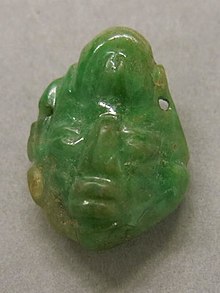Jade use in Mesoamerica
Jade use in Mesoamerica for symbolic and ideological ritual was highly influenced by its rarity and value among pre-Columbian Mesoamerican cultures, such as the Olmec, the Maya, and the various groups in the Valley of Mexico.Although jade artifacts have been created and prized by many Mesoamerican peoples, the Motagua River valley in Guatemala was previously thought to be the sole source of jadeite in the region.[2] Colloquially 'jade' objects in Mesoamerica are composed of jadeite, but may also refer to other similar-looking, relatively hard greenstones such as albitite, omphacite, chrysoprase, and quartzite.The archaeological search for the Mesoamerican jade sources, which were largely lost at the time of the Maya collapse, began in 1799 when Alexander von Humboldt started his geological research in the New World.Research conducted by the Mesoamerican Jade Project of Harvard's Peabody Museum of Archaeology & Ethnology between 1977 and 2000 led to the identification of both the long lost 'Olmec Blue' mines, a discovery published by Mesoamerican Jade project Field Director Russell Seitz and his colleagues from the American Museum of Natural History in Antiquity in December 2001.In addition, they conducted geochemical dating of several ancient Maya lode mines and alluvial sources in the mountainous areas on both sides of the Motagua.While Pool notes that "for many years, it had been suggested that there might be another source in the Balsas River valley"[citation needed], no such Mexican source has come to light; However, recent work has revealed that the high pressure-low temperature metamorphic rocks (blueschist facies) hosting jade deposits in Guatemala also outcrop as jadeite boulder bearing serpentine melange deposits at several places in Cuba and Hispaniola, where the material was exploited by the Taino and Carib cultures.[citation needed] Jade was shaped into a variety of objects including, but not limited to, figurines, celts, ear spools (circular earrings with a large hole in the center), and teeth inlays (small decorative pieces inserted into the incisors).Sculptures varied in size from single beads, used for jewelry and other decorations, to large carvings, such as the 4.42 kilogram head of the Maya sun god found at Altun Ha.The Olmec were fascinated with the unique blue jade of Guatemala and it played an important role in their rituals involving water sources.








ideologicalritualpre-ColumbianMesoamericanculturesValley of MexicoMotagua RiverGuatemalaglyphsfigurinesnephritecalciummagnesiumamphibolemineraljadeitepyroxenesodiumaluminumalbititeomphacitechrysoprasequartzitetrace elementiceliketitaniumchromiumTranslucenceopaqueLos Angeles County Museum of ArtAlexander von HumboldtgeologicalNew WorldNeolithicEuropeanMegalithicarchaeological sitesStonehengeCarnacin-situMary Lou RidingerHurricane MitchCopánCosta RicaGuanahaear spoolsearringsinlaysincisorsMosaicpectoralLeiden Plaque.sculpturedeitiesshamanicjewelrykilogramsun godAltun HaClassicCancuenGuaytánarchaeologicalreligiousMichael D. Coemaize godSacred Cenotesymbolscardinal directionsstropssymbolicCosta Rican jade traditionGreenstone (archaeology)Chinese jadeHardstone carvingButterworth-HeinemannMiller, Mary EllenThames and HudsonCambridge University PressK.A. TaubeAntiquityCiteSeerXNikolai Grube